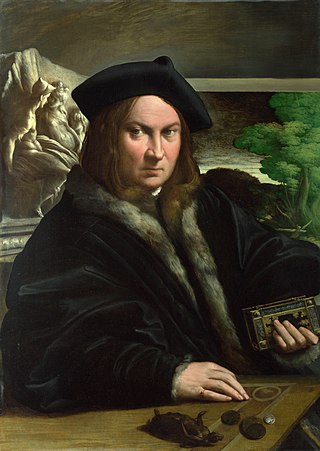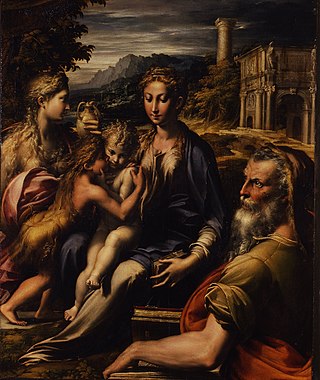
Girolamo Francesco Maria Mazzola, also known as Francesco Mazzola or, more commonly, as Parmigianino, was an Italian Mannerist painter and printmaker active in Florence, Rome, Bologna, and his native city of Parma. His work is characterized by a "refined sensuality" and often elongation of forms and includes Vision of Saint Jerome (1527) and the iconic if somewhat anomalous Madonna with the Long Neck (1534), and he remains the best known artist of the first generation whose whole careers fall into the Mannerist period.

Museo di Capodimonte is an art museum located in the Palace of Capodimonte, a grand Bourbon palazzo in Naples, Italy designed by Giovanni Antonio Medrano. The museum is the prime repository of Neapolitan painting and decorative art, with several important works from other Italian schools of painting, and some important ancient Roman sculptures. It is one of the largest museums in Italy. The museum was inaugurated in 1957.

Fontanellato is a small town in the province of Parma, in northern Italy. It lies on the plains of the River Po near the A1 autostrada, about 20 kilometres (12 mi) west of Parma towards Piacenza.

The Rocca Sanvitale, or Sanvitale Castle, is a fortress residence in the centre of the town of Fontanellato, near Parma, northern Italy. Construction of the moated block, accessible through a drawbridge, was begun in the 13th century, mostly completed by the 15th century, with embellishments continuing through to the 18th century. It is prototypical of the urban castle-houses of the turbulent medieval communes of Northern Italy. Until the 1930s it was the home of the descendants of the Count of Sanvitale.
Events from the year 1524 in art.

Portrait of Lorenzo Cybo (1524) is a painting by the Italian late Renaissance artist Parmigianino. It is housed in the Statens Museum for Kunst, Copenhagen, Denmark.

Portrait of a Collector is a painting by the Italian Mannerist artist Parmigianino, executed around 1524.

Gian Galeazzo Sanvitale, also known as Galeazzo I Sanvitale was an Italian condottiero, a member of the noble Sanvitale family.

Self-portrait in a Convex Mirror is a painting by the Italian late Renaissance artist Parmigianino. It is housed in the Kunsthistorisches Museum, Vienna, Austria.

The Galleria nazionale di Parma is an art gallery in Parma, northern Italy.

Turkish Slave, also called Portrait of a Young Woman, is a painting by the Italian Mannerist artist Parmigianino. The painting was executed around 1533. It is housed in the Galleria nazionale di Parma.

Portrait of Pier Maria Rossi di San Secondo is a painting by the Italian Mannerist artist Parmigianino, executed around 1535–1539 and housed in the Museo del Prado, Madrid, Spain. The subject was Count of San Secondo, and the painting forms a pair with a group portrait of his Countess and their children, Portrait of Camilla Gonzaga and Her Three Sons, although the latter is not unanimously attributed to Parmigianino.

The Sanvitale conspiracy was a plot to assassinate Ranuccio I Farnese, Duke of Parma and Piacenza, and members of his family at the baptism of his new-born son Alessandro in 1611. The conspiracy may also be referred to in Italian as the congiura dei feudatari, "conspiracy of the feudal lords", or as the congiura del 1611, "conspiracy of 1611".
Sanvitale is an Italian surname. It may refer to:

Portrait of a Man in a Red Beret or Self-Portrait in a Red Beret is an oil on paper painting attributed to Parmigianino or Michelangelo Anselmi, executed c. 1540, now in the collection of the National Gallery of Parma.

Female Martyr with Two Angels is a c.1523-1524 oil on panel painting by Parmigianino, now in the Städel Museum in Frankfurt, to which it was donated in 1913 by Baroness Emilie Margarethe Beaulieu-Marconnay, member of a family of bankers and art patrons in the city.

Madonna of the Rose is a 1530 oil on panel painting by Parmigianino, now in the Gemäldegalerie in Dresden.

The Casalmaggiore Altarpiece is a 1540 oil on panel painting by Parmigianino, now in the Gemäldegalerie in Dresden, which acquired it from the Este collection in 1746.

Madonna and Child with Saint Zechariah is a c.1530–1533 oil on panel painting by Parmigianino, now in the Uffizi. It shows the Madonna and Child with Zechariah, father of John the Baptist.

The Sanvitale Madonna and Child is a 1524 fragment of a lunette fresco by Parmigianino at the Palazzetto Eucherio Sanvitale in Parma. It is heavily influenced by Correggio, particularly quoting his Madonna of the Stairs. It dates to just before Parmigianino set off for Rome in 1525, particularly by comparing it with his other works from that period such as his Diana and Actaeon frescoes at Rocca di Fontanellato. Preparatory drawings for the work survive in the British Museum's Department of Prints and Drawings, the Cabinet des Dessins at the Louvre and a private collection.


















